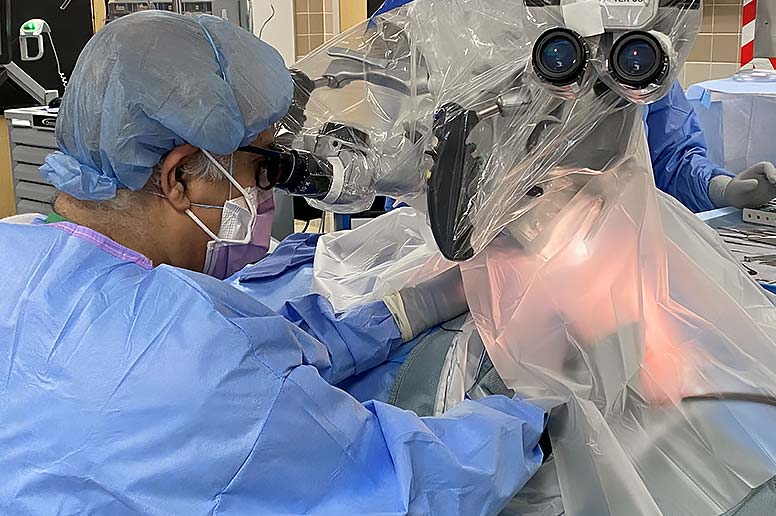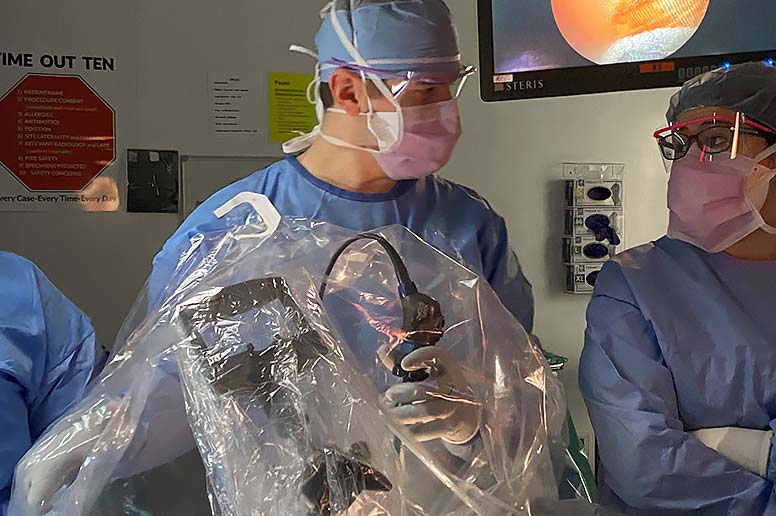Going the extra mile for safety
Innovative OR approach protects patients and staff from COVID-19
With the COVID-19 pandemic in full swing, ear, nose and throat surgeon Arun Gadre, MD, had two patients in need of urgent surgery. One patient had a tumor on his pituitary gland that was causing him to go blind. The second had an infected ear polyp that was growing worse by the hour, placing his brain at risk.
Both surgeries had to be done — and soon.
The procedures were complex under the best of circumstances, involving the use of powerful and highly precise tools. COVID-19 increased the challenge. With the virus spreading fast through communities, Dr. Gadre knew he had to take extraordinary precautions to keep his patients and fellow surgical team members safe. He and his team devised creative and resourceful solutions that demonstrated their determination to go the extra mile to keep patients, and each other, safe.
“The coronavirus spreads through nasal droplets, so aerosolizing tissue fluids with power tools creates a real risk of exposure,” explains Dr. Gadre. “And in the case of the ear surgery, I’d be using a drill that spins at 80,000 RPM, creating a plume of droplets and debris. I had to protect against that.”
“A GPS to ensure accuracy and patient safety”
The pituitary gland is nestled beneath the brain at the top of the sinus cavity. To reach it, Dr. Gadre would go in through one of the patient’s nostrils guided by a neuro-navigation system. “The guidance system acts like a GPS to ensure accuracy and patient safety,” Dr. Gadre says. “Injury to the carotid artery and optic nerve can be catastrophic.”
Dr. Gadre held a brainstorming session with operating room technicians and members of the nursing staff at Geisinger Medical Center, who came in on their days off to help him find solutions. “We even did a dress rehearsal a few days before the surgery to find a way to make the surgery safe,” he says. The team figured out a way to put a protective drape over the neuro-navigator and the patient that wouldn’t interfere with the device’s function.
Their solution for the ear surgery was direct and effective — one extra 3M sticky drape over the microscope. Dr. Gadre’s hands would go under the drape and he’d be protected from the plume his drill would be creating. “It was as if our hands were doing the work inside a tent, while the rest of our bodies were outside,” he explains.
Pandemic calls for rigorous protective measures
Consistent with CDC and state guidelines, Geisinger screens all patients, staff members and visitors for COVID-19. Extra safety precautions include masking, social distancing and deep-cleaning protocols. Dr. Gadre adopted even more rigorous protective measures, drawing on his training as a resident at UC Davis Medical Center during the height of the HIV/AIDS epidemic. “It became standard practice for all of us to double-glove and wear face protection whenever we operated,” he says. “I’ve been doing it for decades. It was hard to adjust at first but now it has become second nature. With testing, there’s always a risk of a false negative, and I choose to approach every surgery as if the patient is indeed infected just to be safe.”
After discussion with the chairman of Otolaryngology-Head and Neck Surgery, Kenneth Altman, MD, Dr. Gadre performed the first of the two surgeries on May 4, using the precautions he and his team had devised to open the sinus cavities. Then neurosurgeon Michel Lacroix, MD, successfully removed the tumor. Patient Zdzislaw Kordecki had been working with Dr. Lacroix for six years. They’d been aware of the tumor and Mr. Kordecki had been having yearly MRIs and field-of-vision tests. Everything had been stable until his vision test in January.
Mr. Kordecki was in surgery for four hours, and in the hospital for three days afterward. Because of COVID-19 visitation restrictions, his wife could only spend 15 minutes with him after the procedure. After that, he got on FaceTime with her to stay connected.
Within two weeks, Mr. Kordecki’s vision was back to normal. And although his condition will be closely monitored, he doesn’t expect to have to do yearly MRIs and field-of-vision tests anymore. “Both doctors took great care of me,” he says. “Dr. Gadre really took his time and explained everything to me. I’m very glad he was on the team.”
Extra safety measures when surgery can’t be delayed
The second surgery was on May 11, and Dr. Gadre again used the safety measures he and his team had come up with. Kenneth Burrows had a severe infection, resulting in excruciating pain in his ear that was not responding to antibiotics. “You can only wait so long with an ear infection this severe,” explains Dr. Gadre. “Otherwise, there’s the real danger of infection moving to the brain.”
To get to the infection, Dr. Gadre drilled behind Mr. Burrows’ ear in a procedure called a mastoidectomy. The surgery lasted more than three hours, but Mr. Burrows went home that same evening. “I don’t even remember leaving the hospital,” he laughs. “But it’s a week later, and I’m doing great.”
Mr. Burrows says he’d wanted to hold off on the surgery because of COVID-19. He’d even had a previous date set up and changed it. But then the pain just got to be too much. “I’m glad I got it done when I did,” he says. “Dr. Gadre did an amazing job — I couldn’t have asked for a better doctor.”
As for Dr. Gadre, he says he couldn’t have asked for a better team. He credits all his team members — including Dr. Lacroix, residents, nurses and scrub techs — for their effort and dedication. “I couldn’t have done it without them. Hats off to this team for coming up with a way of performing these surgeries safely, whether we’re dealing with COVID-19 or any other airborne virus,” he says. “We identified a risk and did what was in the patients’ best interests, while at the same time doing everything we could to keep the surgical team safe.”
We put off the surgery as long as we could because of COVID-19. But I was losing my peripheral vision, so I knew it had to be done. Even though we were in the middle of a pandemic, I felt safe because of the precautions that were taken.”
Mr. Kordecki was in surgery for four hours, and in the hospital for three days afterward. Because of COVID-19 visitation restrictions, his wife could only spend 15 minutes with him after the procedure. After that, he got on FaceTime with her to stay connected.
Within two weeks, Mr. Kordecki’s vision was back to normal. And although his condition will be closely monitored, he doesn’t expect to have to do yearly MRIs and field-of-vision tests anymore. “Both doctors took great care of me,” he says. “Dr. Gadre really took his time and explained everything to me. I’m very glad he was on the team.”
Extra safety measures when surgery can’t be delayed
The second surgery was on May 11, and Dr. Gadre again used the safety measures he and his team had come up with. Kenneth Burrows had a severe infection, resulting in excruciating pain in his ear that was not responding to antibiotics. “You can only wait so long with an ear infection this severe,” explains Dr. Gadre. “Otherwise, there’s the real danger of infection moving to the brain.”
To get to the infection, Dr. Gadre drilled behind Mr. Burrows’ ear in a procedure called a mastoidectomy. The surgery lasted more than three hours, but Mr. Burrows went home that same evening. “I don’t even remember leaving the hospital,” he laughs. “But it’s a week later, and I’m doing great.”
Mr. Burrows says he’d wanted to hold off on the surgery because of COVID-19. He’d even had a previous date set up and changed it. But then the pain just got to be too much. “I’m glad I got it done when I did,” he says. “Dr. Gadre did an amazing job — I couldn’t have asked for a better doctor.”
As for Dr. Gadre, he says he couldn’t have asked for a better team. He credits all his team members — including Dr. Lacroix, residents, nurses and scrub techs — for their effort and dedication. “I couldn’t have done it without them. Hats off to this team for coming up with a way of performing these surgeries safely, whether we’re dealing with COVID-19 or any other airborne virus,” he says. “We identified a risk and did what was in the patients’ best interests, while at the same time doing everything we could to keep the surgical team safe.”



